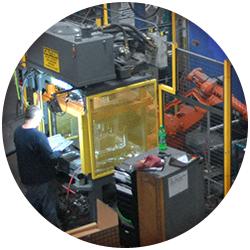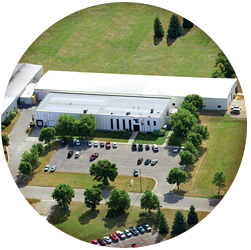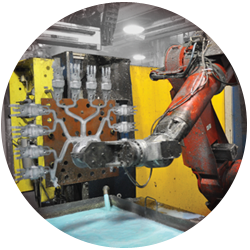Die Casting 101
FAQs
What is Die Casting?
Die casting is an adaptable process that utilizes reusable steel molds, known as dies, to produce a wide variety of engineered industrial, commercial, and consumer parts for practical and cosmetic purposes. These molds can be designed to produce parts with a multitude of sizes, weights, and complex shapes and dimensions. The dies allow for a mass production of high volumes due to their ability to produce accurate parts repeatedly.
What is the Die Casting Process?
The variety of metal parts, ranging from the simple to the more complex and intricate, are made by the repeatable process of die casting. This is done by forcing molten metal under high pressure into the steel molds also known as dies. Die casting machines range in size, typically from 400 tons to 4,000 tons. However, that main difference between machines lies in their means of injecting the molten metal into the die, these methods are either hot or cold chamber. Due to the quick and repeatable nature of this process, die casting is the fastest process when it comes to producing precise non-ferrous metal parts.
Who Buys Die Casting Products?
The initial use of die casting was for printing presses in the 1840’s, the advancement of alloys and technology have expanded the die casting market to virtually all industries. Die casting allows for a variety weights, sizes, and levels of complexity, all the while producing repeatedly accurate parts that lower costs. This has led to die casting parts being found in any industry, from automotive to renewable energy, electronics to hand tools, and from medical to industrial products.
What are the Advantages of Choosing Die Casting?
The die casting process produces a wide variety of repeatedly precise parts, made of strong and dependable alloys, and is capable of versatile machining and finishing operations. Because die casting allows for a faster process and return, die cast parts are lower in cost than the alternatives. As opposed to other casting process, parts made from die casting are still lightweight but are stronger than their plastic alternatives. Furthermore, since die casting does not consist of separate parts joined together, the strength is that of the allow and not of welding or other joining process. Due to the versatile die casting opportunities, die casted parts can be made in a variety of shapes and sizes to fit a customers’ needs and specifications.
What are the Benefits of Aluminum and Magnesium?
Aluminum and Magnesium offer their own advantages as a die casting part. Aluminum offers a variety of benefits for a multitude of designs and uses. The alloy is lightweight, allowing for thinner walls all the while stable and strong. This proves a special advantage for designs with complex and intricate dimensions. Aluminum parts are able to maintain that strength at very high temperatures, and boasts high thermal and electrical conductivity, quality mechanical properties, and effectively resists corrosion. With many of the same characteristics as Aluminum, Magnesium is also considered the easiest to machine. It is the lightest of the alloys, with exceptional strength-to-weight ratio.
If you want to learn more about the die casting process, Contact TCDC to inquire about a presentation, or to customize a seminar to meet your educational objectives.









